
So we've been here six days now and it's been a whirlwind of subways, getting lost in prefectures, documenting urban conditions, photographs, walking for miles and miles a day and late nights drinking. The wheels are starting to come loose and might fall off if we keep this pace up. Tomorrow's our last full day in Tokyo so we're trying to make the most of it before getting back to LA. We've gotten to see some amazing projects and it's been an incredible trip. Learned a lot of the culture (sometimes through less than desirable and unfortunate circumstnaces) but wonderful all the same.
Moriyama House by Nishizawa was incredible. 

You really don't get the full impact of it without visiting. The tight spaces and compartmentalized living somehow manages to work together as a whole. FOA's Port Terminal was also another fun one. Conceptually it's really nice but the experience of the section isn't as strong as I would've hoped.
[img]
Still really impressive all the same. Herzog and de Meuron's Prada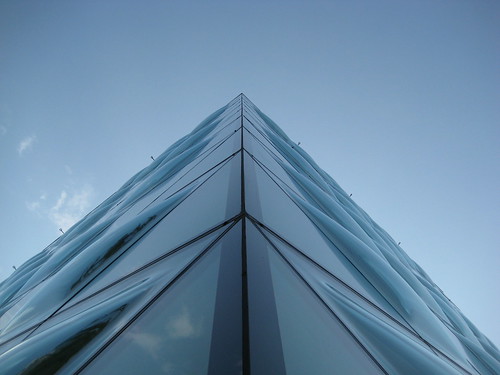
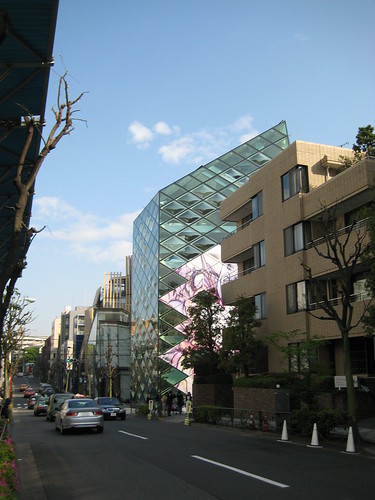
is a great building that was much better than I expected while Tod's by Ito was a little bit of a let down. The interior spaces were wholly disconnected from the structural facade and really was just sort of generic. Gyre by MVRDV was a nice building but I think it was a little bit unsuccessful in it's ideas of the spiral circulation. The concept is a bit weak but the building is a nice building itself. Dior was quite nice by SANAA (adjacent to the MVRDV) but some of her other projects are much nicer. Today I saw the Olympic Stadium by Tange which is a really nice project. The structure is really impressive. LV in Roppongi is really nice and it's nice to see ideas in screening actually realized. The effect of the tubes is really done well and is funny as a classmate did something similar last quarter. Ando's Omotesando Hills is a nice project and is similar in concept to what I'm toying with right now but has a lot of circulatory shortcomings. The ramp starts to obfuscate wayfinding. Good to see but I'll have to try to do better.
The meeting on the second day with Yoshiharu Tsukamoto went well. I was quite nervous presenting to him at first and had a little bit of a damp brow through it all. But seeing Atelier Bow-wow was really great and we got some good feedback and discussion going about Metabolism and Void Metabolism and the urban condition of Tokyo. 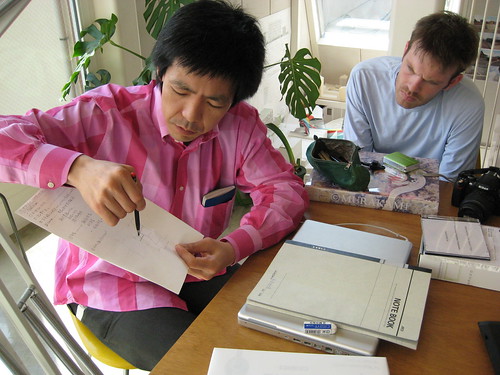
It was interesting as we've been studying what he coins "Void Metabolism". It's essentially the current generation of relatively young architects in Japan that are interested in the "Void". Though I think the idea of "Void" is a misnomer as it tends to imply something analogous to negative space. It's better described as Relational Space. The idea being that you can use these liminal spaces as a point of departure for your design and really make spaces experiential through the manipulation of these.
We've started to come up with ideas that are generated by the relationship between interior and exterior spaces and respectively to themselves as well. However, Tsukamoto felt that Void Space really was more of a contextual relationship to the adjacencies and site conditions. If it became internalized in architecture, it's hard to bring the idea back to a macroscopic scale and use it as a tenet of a means of practicing.
Anyway. Discussion went well and it was very thought provoking. The next day he took us to Tower House and we were graciously welcomed by the owners who were exceptional hosts. 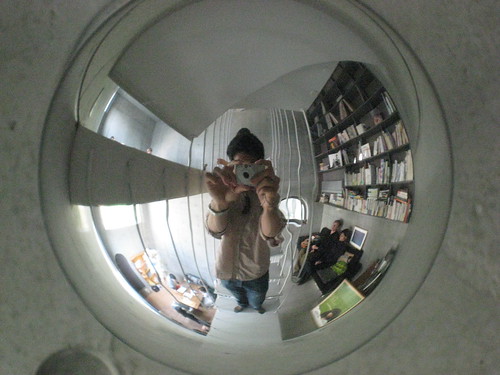 . Again the tight spaces and staggered floors are very successful. It feels good to have ideas validated and to be convinced by actually seeing the projects.
. Again the tight spaces and staggered floors are very successful. It feels good to have ideas validated and to be convinced by actually seeing the projects.
Seeing SANAA's offices was really incredible as well. Good lesson in how an office can be an opportunity to practice controlled chaos. It someways it's the architectural practice equivalent to the chaos of the crowd at the Tsujiki Fish Market. Somehow it all just works though you expect a massive collision to happen at any second.
Too much wonderful stuff to mention and I'm about to pass out after a long day of miles and miles of walking.
Few more photos...
Plug-in infill bldg that I think is really interesting. A little metabolist...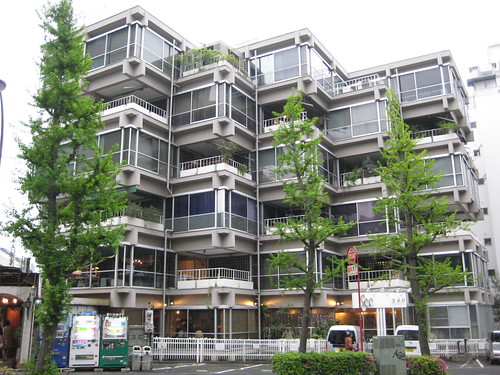
FOA Yokohama Port Terminal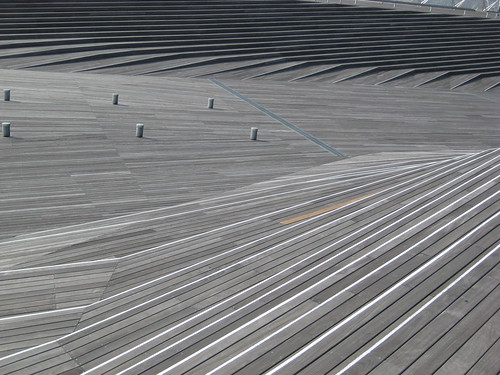



13 Comments
is there a word other than "nice" to describe or evaluate projects?
yes. i could get into it but i wrote the post at like 2 am. sorry. i'll do a complete rundown when i get back stateside.
I always loved that wood roof's waves.
As for the Void. I actually think "relational space" does capture the notion better.
It does seem as if a generation of architects has become increasingly focused with issues of liminality. Specifically the use of and contexts (including socially) created by such spaces within the realm of urban (read macro) scale design.
Even if the intervention is via the small (read often residential) project.
Nice to see your blog and get your perspective on some of the same sites that i was at. (Though i respectfully disagree with some of your assessments).
Void architecture is one of my favorite things about Japan - very phenomenological. Ando has a very elegant quote about this occurrence:
If you give people nothingness, they can ponder what can be achieved from that nothingness.
I'd love to see some more of your pictures, when you get the opportunity to upload them. Do you post on Flickr?
"nice" works for me as critique. what else is there to say really?
all that archi-spectacle in omotesando is enough to make any architect think there is no point to the profession at all. i agree with your take on the works. prada is a jewel, though too prescious for my taste, while the rest is just...well...nice. not great. better than average, but functionally not unique, does little for the context except work as backdrop...so....nice. mvrdv's latest is a bit better cuz it tries to do someting spatial...but ends up...nice. don't know why. maybe it is the takenaka input.
which is why tsukamoto is so impt to the discourse. and places like the moriyama house, too. it is sign of an approach to the city that says ok fuck the history of making objects, lets treat this god-forsaken city like its a legitimate landscape and move on...so you get to be spatially interesting without worrying about blocking views and ensuring privacy and the endearing cute-ness of so much japanese architecture is allowed to just get droppped. well, ok, that is maybe what my partner and i are trying to do here, and i am just seeing what i want...but i think it is good way to make sense of tokyo architecture scene lately...
in that context i think ando and tsukamoto are on opposite spectrum of void. ando was about escaping, creating respite and a place to breathe. tsukamoto says there's nothing wrong with the air and just goes to town... it is why i think omotesando hills feels kind of suffocating in the end. it feels like the void has become howard hughes in his hotel room spraying himself with disinfectant.
btw, i was also dissapointed with TODs. great structure, but spatially dead. my favorite part of the whole store was the purple sofa-things inside...but turns out they were designed by zaha hadid. i heard ito complainign about it once. seems he wanted to do his own furniture and the owner declined...good call i think (much as i love ito and his work).
thanks for the comments.
Photos from the trip are flickr'ed here
As per tsukamoto's work, I loved the bow-wow offices that we got to see and thought they were great. Certain attentions to the void like allowing a large window to face directly onto the wall of the adjacent building I thought were especially poignant and unexpectedly successful.
With respect to the Void, I think that Tsukamoto is much more interested applying and manipulating it in the relationship between buildings and adjacencies and the project and not so much the spatial conditions within the project itself. Our studio started to explore the implications of applying Void to the internal conditions of continuous spaces and blurred boundaries, but he was quite adamant that it should not be overly internalized.
jump- i totally agree with omotosando hills. it's extremely stifling and despite it's clear circulation, it feels carcerally piranesian.
I think a tough thing is that a lot of these kinds of strategies are scalar. Our studio research is focused a lot on what these current Void Metabolists are doing and the strategies they employ and trying to mine that for strategies that can be applied on a more universal context. But we're finding it tough as the concept of "relational space" between buildings and context become difficult when dealing with a large scale building and/or even a totally different urban context. Anyway... uploading the last of the photos and doing another post tomorrow.
look forward to what you end up doing.
i agree about scale, and it is where tsukamoto's work begins to fall apart. as a strategy for the small scale it is brilliant, and i have to admit my partner and i have taken some lessons from the bow-wow. but when it becomes big, when urbanism is not just sort of "fit into", like a surfer shooting a curl, the approach falls apart. how do you create context with the approach? the answer i think is that you don't. it isn't an idea that allows creation in that sense, only emulation and modification...which is problematic if you have large ideas.
again i am maybe reading too much into the topic, but these are ideas we are struggling with and trying to write about and use in our work here in tokyo...so it is kind of convenient/self-serving to slip it in here...hope you don't mind too much...
not at all. in that sense it's sort of legitimizing our studio research. UCLA, with the arrival of Hitoshi Abe as our dean has been conducting a lot of cross-cultural studies with the idea of using the Tokyo/LA comparison as a point of departure. Not trying to sound too polemic, but I think that it's been very difficult and the studios that have been studying Tokyo/LA have struggled with this a lot. Hopefully we don't run into a dead end...
Seems like such cross-cultural study would be especially fruitful. Considering the issues of density and scale confronting both cities. The Japanese seem to have found ways to address this in their urban scale. Often through it seems, almost not addressing it in any sort of planned-unfied/singular approach.
I think that with relational space and the macro scale the issue is specifically allowing the space to create the context. It is reflective or more accurately a response of/to of not the creation of the relational/voidal context.....
I'm not trying to be argumentative when i say this and i am looking for some other peoples' views on this, but while the cross-cultural study could be considered fruitful, i seriously question the effectiveness of the application of anything learned from the Japanese urban condition in the States. It seems to me that socially they are two viciously opposed agendas and trying to fit one into the other would result in failure. I am talking specifically about both the average residential condition in Japan and the use of "empty" space in Japan. The Japanese have learned to deal with both these conditions differently because their societal outlook is very different from the US (simply reduced, less is more, versus more is more). I (sadly) don't think that America is at the point where we can accept this type of urbanism or residential response. Thoughts?
Morph,,
While i agree that sociologically/pyschologically the United States (and it's people) have historicall had a diferent societal outlook when dealing with such issues, i would argue (or at least hope) that we in the US. are becoming more aware/accepting of the necessity of recognizing the existence of and the importance of using such empy space (aka liminal spaces) whether within the context of brownfields, or urban infill, smaller houses for eco means whatever.
Perhaps not all of the country, but more and more and certainly within the design (particularly urban design) profession.
well, this is the average residential condition in japan:

tokyo is not japan anymore than manhattan is the united states.
so the lessons to take from tokyo are probably not exactly the ones you might need to deal with LA. on the other hand japan is founded on exactly the same christian evangelical vision for family life in a city that was popular in north america about 100 years ago - which is to say japan is founded on the nuclear family, on suburbia, and commuting to the centre...all in order to protect innocent hildren from the corruption of the city.
that view continues in both japan and america today...so parallels are pretty easy to make if you want to make them.
tokyo housing is kind of extreme, but the stuff in the centre is for the rich mostly. if you want to live downtown you have to be able to afford very very high rent. say $1000-5000 a month for 1000 ft 2 flat in a so-so area. $15000/month for the higher middle class. and BUYING land? fogetabout it. that is a special condition with special results and the degree to which it can be made into general lessons for anywhere but tokyo is hard to say. but the places where most japanese live, ie, suburbia in small cities around the country...there is something there for sure.
my own feeling is that the real important thing about seeing other cultures is to learn to be objective about your own.
as a final thought i am not sure what liminal space is, nor void and all of that. sure the words i understand, but it is impt to not romanticise japan too much, and not bestow too much meaning on things here. things are muddy enough without imagining a social condition as well...
i have never been to japan, so i can't make a comparison between japan and the u.s.. now i am back to asia after living in the states for almost 2 decades. there are a number of academic disciplines architects can learn from although in reality, that is not so encouraged. i recently picked up a book about economic developments in east asia after world war 2, and as you know, japan has had state protected capitalism compared to liberalism in the states. i think that analogy can be used to understand lots of urban and cultural phenomena, but i am a bit concerned about the situations in the u.s. especially after 9/11 because what i liked about the u.s. when i first went there in the 80's was free air. just in general people were freer not in pretentious ways from fears but really from more free spirits in the air. one can imagine things may become more state controlled to fix the problems, but i would not approach it from fear. i find a lot of good things to learn from japan but as jump points out would not romanticize. i think it is more important to think about gender issues because women's mental spaces are different from hierarchical male mentality. things about void, i think you will agree that the concept originated form taoism, so it is a mental space which means to apply in the architecture means a metaphoric description or an artistic expression at best unless you are really good to be able to create that sort of spatial experience. it is probably too better used as an analytic tool than form making device, and maybe women are better equipped to understand that concept both physically and mentally. as you may know, taoism is rooted in feminism although later taoists became perverted with sexuality, and taoism became associated with sex. i think it started as a political conspiracy. (there are a few books on the subject such as 'the sexual teachings of the white tigress', 'The Sexual Teachings of the Jade Dragon: Taoist Methods for Male Sexual Revitalization' if you are interested.) but anyways, when i went to las vegas and saw the housing development in peripheries, i was intimidated by the sameness and lack of melody. just several notes in rhythm can produce music, and i was wondering what is stopping the development from using a few prototypes to be applied in rhythmic intervals. about gender issue, i think urban environment can benefit from using feminine creativity. (i am thinking sejima san, hasegawa san and kaju makino.)
Block this user
Are you sure you want to block this user and hide all related comments throughout the site?
Archinect
This is your first comment on Archinect. Your comment will be visible once approved.